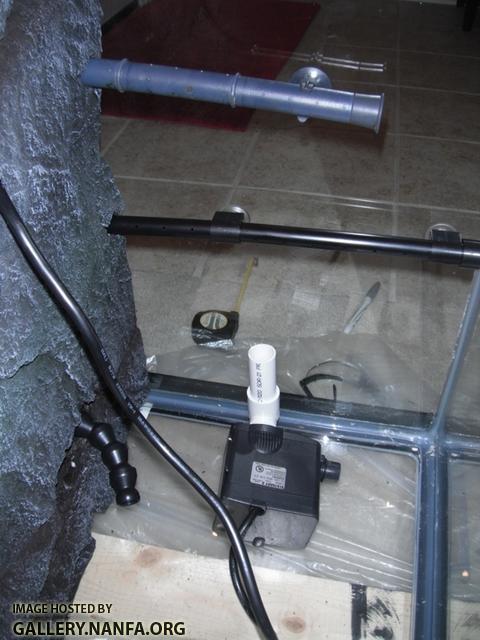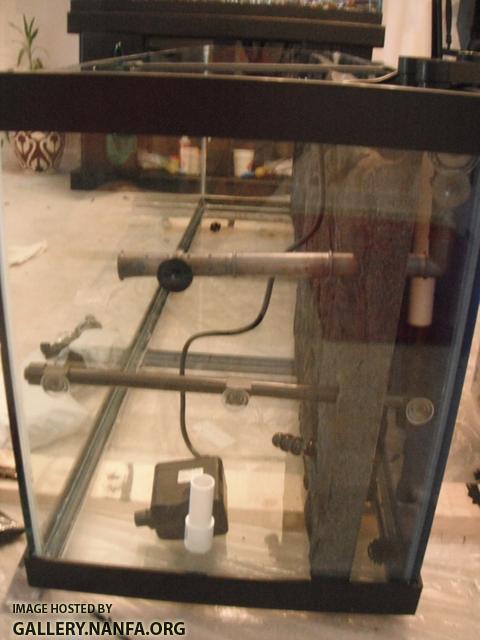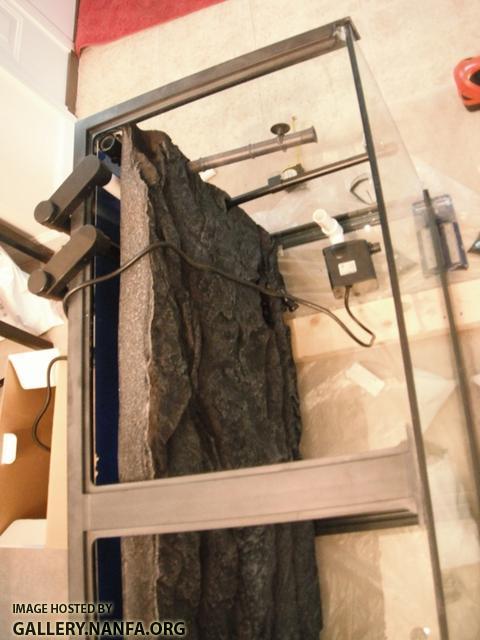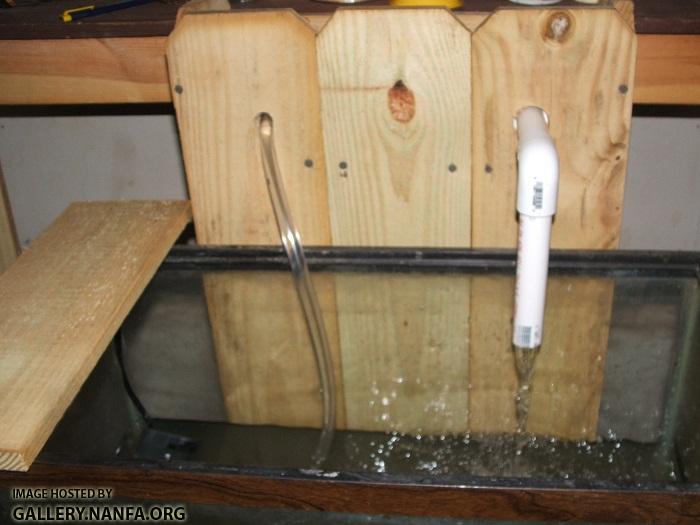Josh Blaylock's 125 gallon stream tank. Build and updates.
#61
 Guest_NVCichlids_*
Guest_NVCichlids_*
Posted 20 April 2011 - 05:21 PM
#62
 Guest_jblaylock_*
Guest_jblaylock_*
Posted 20 April 2011 - 08:53 PM
That should be enough. The only thing really worth being concerned about is enough oxygen in the water back there to prevent anaerobic conditions. That can result in nitrates and such being converted back into ammonia. However, even small amounts of oxygen is enough to prevent that. Even in fairly dense soil it still requires a significant depth before anaerobic conditions set in, unless the nitrates are so bad that it locally consumes all the oxygen in the breakdown process. That would be bad for your tank all the way around, with or without the background.
I'll be running 3 large cannister filters and one of the returns will have an airline hooked to it with an air pump and will put O2 into the tank nearly all day long.. I try keep my tanks well oxygenated. Also, I plan to put a layer of bio-balls behind the background to help. I wouldn't think anaerobic conditions would exist with a pump putting air in all day long, do you think mywan?
I ended up getting a background from Designs by Nature. 1st, their customer service was great as I had a lot of questions for them before I bought and they were great and responded quickly. 2nd, their natural backgrounds are amazing, I'm thinking of getting a precut one for my 10gal in my office! I went with the Bulu Point - Gray, seen HERE. This was the best fit for me, concerning the size, depth, look, etc... Though the gray Buldge had tons of features, it just took up too much room.
#63
 Guest_mywan_*
Guest_mywan_*
Posted 21 April 2011 - 04:56 AM
With air pumped in anaerobic conditions is simply not possible. The active bacteria in biofilters consume oxygen to do there breakdown job and some of these bacteria can actually start making ammonia if they run completely out of oxygen. But it takes rather extreme oxygen depletions for that to occur. Even fairly deep in a soil substrate enough oxygen remains that it does not happen. In deep soil, by the time it is deep enough for anaerobic conditions, it tends to be deep enough to not be a concern for the water quality, even if it bubbles up occasionally. If pockets of rotting matter is buried the oxygen consumption rate can sometimes be high enough you get very localized anaerobic conditions nearer to the surface, but so long as the oxygen and nitrates content of your aquarium stays good even that is not a real concern.I'll be running 3 large cannister filters and one of the returns will have an airline hooked to it with an air pump and will put O2 into the tank nearly all day long.. I try keep my tanks well oxygenated. Also, I plan to put a layer of bio-balls behind the background to help. I wouldn't think anaerobic conditions would exist with a pump putting air in all day long, do you think mywan?
With bioballs and a source of oxygen back there it is nothing more than a normal healthy part of your aquarium filter.
Maybe one day I will try my hand at some artsy 10, 15, and 20 gallon backgrounds that are low profile enough and are more than sufficient as the sole filter for the aquarium. Including top loaded filter, carbon, and bioball reservoirs. Circulation can be either impaler or air driven. Air driven would be the easiest and cheapest. Not requiring any other internal or external filtration gives a little more headway in space so it can be slightly thicker in the corners than in the middle. Also designed for the DIYer to use alternative filter medias. I tend to dislike the unwieldy single purpose constructs that DIYers and commercial products both tend to produce. I guess in the pet trade a cheap tank while nickel and diming every little single use accessory is profitable, and DIYers are limited by available parts and objectives. With some exceptions the aquarium hobby could potentially be a very cheap hobby. By raising the bar on what constitutes costly and extravagant it increase the retention of hobbyist and increase the total money available to the hobby trade.I ended up getting a background from Designs by Nature. 1st, their customer service was great as I had a lot of questions for them before I bought and they were great and responded quickly. 2nd, their natural backgrounds are amazing, I'm thinking of getting a precut one for my 10gal in my office! I went with the Bulu Point - Gray, seen HERE. This was the best fit for me, concerning the size, depth, look, etc... Though the gray Buldge had tons of features, it just took up too much room.
#64
 Guest_jblaylock_*
Guest_jblaylock_*
Posted 21 April 2011 - 08:01 PM
#65
 Guest_shyro77_*
Guest_shyro77_*
Posted 21 April 2011 - 09:07 PM
#66
 Guest_mywan_*
Guest_mywan_*
Posted 21 April 2011 - 09:18 PM
#67

Posted 22 April 2011 - 08:53 AM
If that is the case, then I say "yes" there is some advantage. Tanks are really heavy and you will not normally want move them often. If you leave enough space behind the tank for your fist, then you can work back there is you ever need to (this is one of many reasons why a lot of tank stands and hoods do not really have full backs... like I seem to remember yours does not). So what is a fist width? Maybe 4 inches? I have made that error once before and could not even get a HOB filter to fit... a few extra inches behind the tank will be helpful in the long run.
#68
 Guest_nativeplanter_*
Guest_nativeplanter_*
Posted 22 April 2011 - 01:19 PM
The active bacteria in biofilters consume oxygen to do there breakdown job and some of these bacteria can actually start making ammonia if they run completely out of oxygen. But it takes rather extreme oxygen depletions for that to occur. Even fairly deep in a soil substrate enough oxygen remains that it does not happen. In deep soil, by the time it is deep enough for anaerobic conditions, it tends to be deep enough to not be a concern for the water quality, even if it bubbles up occasionally. If pockets of rotting matter is buried the oxygen consumption rate can sometimes be high enough you get very localized anaerobic conditions nearer to the surface, but so long as the oxygen and nitrates content of your aquarium stays good even that is not a real concern.
I'd say it's not a real concern even if you do get anaerobic conditions near the surface. In most freshwater systems, dissimilatory nitrate reduction to ammonia is far outpaced by dentrification. DNF can be inhibited in environments with high organic carbon, reduced sulfur, and salt (which is why DNRA can make up a larger percent of the total NO3- removal pathway in estuaries). But in freshwater systems it is a small percent and much of the resulting ammonium is thought to go right back into the N cycle by nitrification.
#69
 Guest_jblaylock_*
Guest_jblaylock_*
Posted 23 April 2011 - 03:20 PM
#70
 Guest_Doug_Dame_*
Guest_Doug_Dame_*
Posted 23 April 2011 - 04:02 PM
I've had decent luck using furniture sliders to make tank stands movable on wood and carpet floors. Have not yet tried on a concrete floor of garage/fishroom.I think Josh was talking about space between the outside back of the tank and the walls of his house...
If that is the case, then I say "yes" there is some advantage. Tanks are really heavy and you will not normally want move them often. If you leave enough space behind the tank for your fist, then you can work back there is you ever need to (this is one of many reasons why a lot of tank stands and hoods do not really have full backs... like I seem to remember yours does not). So what is a fist width? Maybe 4 inches? I have made that error once before and could not even get a HOB filter to fit... a few extra inches behind the tank will be helpful in the long run.
In the old place, I had a 2" round slider under each leg of a conventional wrought iron stand. The rack was loaded with two 55g tanks, which is a lot of weight, but I was able to single-handedly move it away from the wall for maintenance, and put it back. (I'm not saying it was EASY solo ... traction becomes a problem ... but two people could have moved it easily.)
The stand I'm slowly getting towards making for a custom-70 will have 10 sliders, basically one per foot along the bottom perimeter.
It is best to install these things before the water goes in.
#71
 Guest_jblaylock_*
Guest_jblaylock_*
Posted 24 April 2011 - 03:52 PM



#72
 Guest_jblaylock_*
Guest_jblaylock_*
Posted 24 April 2011 - 05:46 PM
This is what I drilled....roughly:
5 - 5/8in holes
4 - 1/2in holes
6-7 - 3/8in holes
10ish - 7/32 & 1/4in holes
These are drilled all over the background. I don't want to create a situation where there is strong suction through the holes, and there is not enough circulation. Should I make a few more bigger holes? I can always put a large rock in front of it.
#73
 Guest_mywan_*
Guest_mywan_*
Posted 24 April 2011 - 08:29 PM
With a 160 gph pump through 3.4 square inches you are only pumping 47 gallons per hour per square inch. That is only 0.013 gallons per second per inch, or a flow rate of about 3 inches per second. Absolutely minuscule and nothing to worry about. Many bugs will crawl faster than that.
#74
 Guest_jblaylock_*
Guest_jblaylock_*
Posted 24 April 2011 - 08:38 PM
2 Fluval 405 - 340gph each = 680gph
1 Eheim Pro II = 250gph
Total 930gph
This would be 273 gallons per hour per square inch. What would the flow rate be on that through the holes, 18inches per second?
Edited by jblaylock, 24 April 2011 - 08:41 PM.
#75
 Guest_mywan_*
Guest_mywan_*
Posted 24 April 2011 - 09:40 PM
In particular:
1) How many of these filters take water from behind the background and how many take it from the main tank.
2) How many return the water to behind the background and how many return the water to the main tank.
If my guess that you are taking all water from behind the background and returning it to the main tank is correct, then if the holes are not keeping up with the flow the water level behind the background will drop. If this happens add more holes. If the level remains equal on both sides of the background then you have sufficient flow rate through the background at a safe rate.
If you have any pumps taking water from the main tank or feeding back behind the background then that flow does not count toward flow through the background. So I need to know where every intake and output actually are.
#76
 Guest_jblaylock_*
Guest_jblaylock_*
Posted 25 April 2011 - 11:45 AM
#77
 Guest_mywan_*
Guest_mywan_*
Posted 26 April 2011 - 12:29 AM

This in on a 160 GPH pump gravity feed back into the tank through a 3/4' inch diameter hole. It does not even make full use of the 3/4' inch hole but we will assume it does as a safety factor and take this as a baseline for an acceptable flow rate.
This gives us, 362 gph/square inch or 0.1 gps/square inch. This comes to a flow velocity of 23.24 inches/second, which is significantly greater than the flow velocity your 3.4 square inches of holes require to keep up with your 930 gph pumps. You have plenty of holes with a very significant margin of safety for a gravity feed to keep up with 930 gph.
To estimate the potential for trapping fish I used the slowest swim speed listed here:
http://www.stream.fs...Speed_Tests.htm
The slowest was a central stoneroller (even slower than a goldfish) with a prolonged swim speed was over 15.7 inches/second, and a burst speed of very near 36 inches/second. Most were far faster. This means that even if you left the holes open the fish would be able to swim back and forth through the holes with a 18 inch/second water velocity. This velocity is defined to be inside the hole, so even a mere 1/4 inch from the hole greatly reduces the effective water velocity on the fish.
Your holes are fine.
Edited by mywan, 26 April 2011 - 12:35 AM.
#78
 Guest_jblaylock_*
Guest_jblaylock_*
Posted 26 April 2011 - 02:01 PM
I needed something to compare this flow rate to, so I based it on this gravity feed flow velocity:
This in on a 160 GPH pump gravity feed back into the tank through a 3/4' inch diameter hole. It does not even make full use of the 3/4' inch hole but we will assume it does as a safety factor and take this as a baseline for an acceptable flow rate.
This gives us, 362 gph/square inch or 0.1 gps/square inch. This comes to a flow velocity of 23.24 inches/second, which is significantly greater than the flow velocity your 3.4 square inches of holes require to keep up with your 930 gph pumps. You have plenty of holes with a very significant margin of safety for a gravity feed to keep up with 930 gph.
To estimate the potential for trapping fish I used the slowest swim speed listed here:
http://www.stream.fs...Speed_Tests.htm
The slowest was a central stoneroller (even slower than a goldfish) with a prolonged swim speed was over 15.7 inches/second, and a burst speed of very near 36 inches/second. Most were far faster. This means that even if you left the holes open the fish would be able to swim back and forth through the holes with a 18 inch/second water velocity. This velocity is defined to be inside the hole, so even a mere 1/4 inch from the hole greatly reduces the effective water velocity on the fish.
Your holes are fine.
Wow, thanks mywan. I really appreciate your help...and math.
#79
 Guest_jblaylock_*
Guest_jblaylock_*
Posted 26 April 2011 - 09:24 PM
I anchored 1 piece of driftwood today, 1 more to go. Hoping the tank frame comes in this week so I can get the background and frame installed this week, just about finishing it all up.
#80
 Guest_jblaylock_*
Guest_jblaylock_*
Posted 28 April 2011 - 04:03 PM
0 user(s) are reading this topic
0 members, 0 guests, 0 anonymous users









